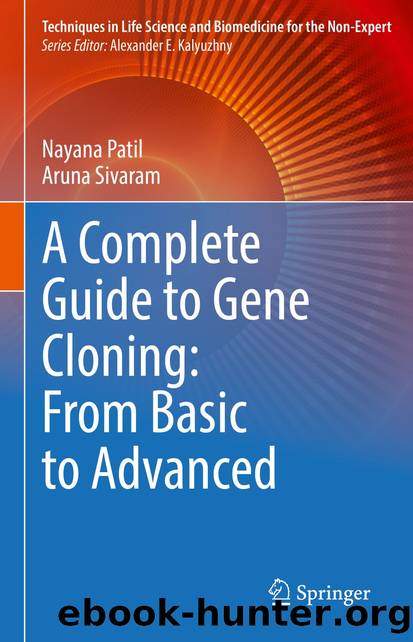A Complete Guide to Gene Cloning: From Basic to Advanced by Nayana Patil & Aruna Sivaram

Author:Nayana Patil & Aruna Sivaram
Language: eng
Format: epub
ISBN: 9783030968519
Publisher: Springer International Publishing
Single entry clone genes can be easily subcloned into a variety of destination vectors [13].
Disadvantage
It is difficult to switch to another recombination system (lack convenient restriction endonuclease sites and start and stop codons are removed).
Recombination enzymes are very expensive where the vector sets are defined by the supplier and often require proprietary enzymes to be used [14].
5.6 Mating-Assisted Genetically Integrated Cloning (MAGIC)
A highly engineered process of in vivo cloning âMating-Assisted Genetically Integrated Cloningâ or MAGIC was developed by Li and Elledge enabling rapid assembly of recombinant DNA molecules. During bacterial mating, it uses site-specific DNA cleavage and homologous recombination. The transfer of DNA fragments is aided by specifically made âdonorâ and ârecipientâ vectors (e.g., insert with specific recipient expression vectors and donors). The recombination events do not need any DNA preparation or in vitro manipulations. Recombination events are genetically chosen which results in the efficient positioning of the target gene under the control of new regulatory elements [7]. As this new method involves mixing of bacterial strains, it brings about a high-throughput recombinant DNA production that is seamless, saves time and effort.
Bacterial mating can efficiently transfer large DNA fragments (>100 kb). The donor strain must have conditional origin of replication and is nonfunctional in the recipient strain Two genetic systems initiate homologous recombination when the two strains are in the same cell. The first is by I-SceI site-specific endonuclease activity over donor and the recipient. The second is the lambda recombinase system which brings about homologous recombination between 50 bp. Combining all these features allows efficient and enhanced transfer of fragments from the donor vector onto the recipient [15].Advantages
The technique permits bacteria to mix inserts and vectors, allowing constructs to be generated without restriction enzyme digestion, gel purification, or the use of recombination-promoting enzymes [15].
Download
This site does not store any files on its server. We only index and link to content provided by other sites. Please contact the content providers to delete copyright contents if any and email us, we'll remove relevant links or contents immediately.
| Anatomy | Animals |
| Bacteriology | Biochemistry |
| Bioelectricity | Bioinformatics |
| Biology | Biophysics |
| Biotechnology | Botany |
| Ecology | Genetics |
| Paleontology | Plants |
| Taxonomic Classification | Zoology |
Sapiens: A Brief History of Humankind by Yuval Noah Harari(14145)
The Tidewater Tales by John Barth(12564)
Mastermind: How to Think Like Sherlock Holmes by Maria Konnikova(7145)
Do No Harm Stories of Life, Death and Brain Surgery by Henry Marsh(6831)
The Thirst by Nesbo Jo(6748)
Why We Sleep: Unlocking the Power of Sleep and Dreams by Matthew Walker(6540)
Life 3.0: Being Human in the Age of Artificial Intelligence by Tegmark Max(5395)
Sapiens by Yuval Noah Harari(5253)
The Longevity Diet by Valter Longo(4986)
The Body: A Guide for Occupants by Bill Bryson(4864)
The Rules Do Not Apply by Ariel Levy(4779)
The Immortal Life of Henrietta Lacks by Rebecca Skloot(4441)
Animal Frequency by Melissa Alvarez(4360)
Why We Sleep by Matthew Walker(4305)
The Hacking of the American Mind by Robert H. Lustig(4256)
Yoga Anatomy by Kaminoff Leslie(4237)
All Creatures Great and Small by James Herriot(4182)
Double Down (Diary of a Wimpy Kid Book 11) by Jeff Kinney(4123)
Barron's AP Biology by Goldberg M.S. Deborah T(4055)
